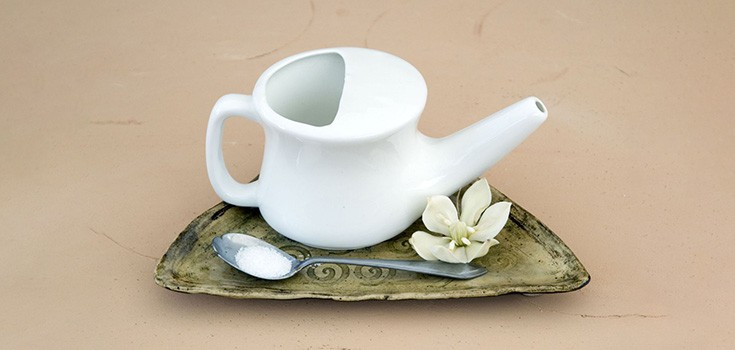Nasal Irrigation (Jala Neti) to Alleviate Sinus Problems, Congestion, Hay Fever

In ancient Ayurvedic medicine and yogic science, irrigation of the nasal passages is said to balance two important energy centers called the Ida and Pingala nadis, but in modern use, Jala Neti, the Sanskrit term for the flushing of water through our nasal passages, is a wonderful way to clear the symptoms of Hay fever, sinus pain, facial pain, headaches, halitosis, anterior rhinorrhea (watery discharge from the nostrils), and nasal congestion associated with seasonal changes or even the common cold. It can also be used to improve powers of concentration and has been said to help quit smoking by deprogramming the brain from the psychological addiction.
The practice has become vogue again after thousands of years of use, giving relief to people with sinus issues. It has been reported on at Harvard, in the New York Times, and even touted on the Oprah Winfrey show, but yogis have been practicing nasal irrigation since the times of the Rigveda. In ancient practices nasal irrigation was used to improve meditation, and bring forth a heightened awareness.
Jala Neti can be used in tandem with dietary changes and herbal remedies for sinus problems, often with outstanding results. Most importantly, individuals report experiencing many fewer symptoms of sinus headache, Hay fever, itching, sneezing, and post nasal drip, along with allergies, bronchitis and asthma, without having to use cold medications or prescription drugs.
Practicing Nasal Irrigation, the Neti Pot
To practice Jala Neti, it is ideal to make your water/salt solution the same salinity as human blood, about 0.9%. This isotonic solution should only utilize organic sea salt and purified water, never tap water and iodized table salt. You can estimate, without having to be exact, but mixing one tablespoon of salt for a liter of water should be sufficient. You can also slightly warm the water over the stove to completely mix in the salt, but make sure the water is not too hot before practicing nasal irrigation. If the water is tepid, it is fine for Jala Neti.
Next, simply pour the water into your neti pot, found in any drug store or online dispensary. Leaning your head over a sink, or outdoors, pour the entire contents or the neti pot through one nostril while tilting your head to one side. The water should flow effortlessly through your nasal cavities from one side up and out through the other side and onto the ground or into the sink.
It shouldn’t take more than about 30 seconds to flow through. Blow excess mucous and water out before doing the opposite nostril. Repeat again for the other side with a full neti pot of saline water. Fully clear and dry the nostrils by blowing the nose well after completing the irrigation on both sides.
After practicing Jala Neti, if you still feel a sinus blockage you can repeat several times to alleviate it. If there is still no improvement, consider seeking a doctor to determine if you may have a deviated septum or other bone abnormality that may be causing sinus problems.

It's been almost two years since I began using nasal irrigation. I've tried many of the devices being used today and have decided that simpler is better.
My favorite device for nasal irrigation is a simple squeeze bottle. It let's me simply run water through like the neti pot used in Jala Neti. But it also let's me add a little force to the water if I want to, and even pulsate the water stream with quick squeezes.
I find that the added force and pulsations sometimes dislodge the mucous etc. more effectively.
There are battery driven devices for pulsating the water but batteries and water don't mix too well. The two I tried both died pretty quickly and I wouldn't recommend either of them. I also didn't find the pulsations as effective as the squeeze bottle.
Read more about nasal irrigation, how to do it and why it's so good for you at this website: http://consumerreportscenter.com/saline-solution-…